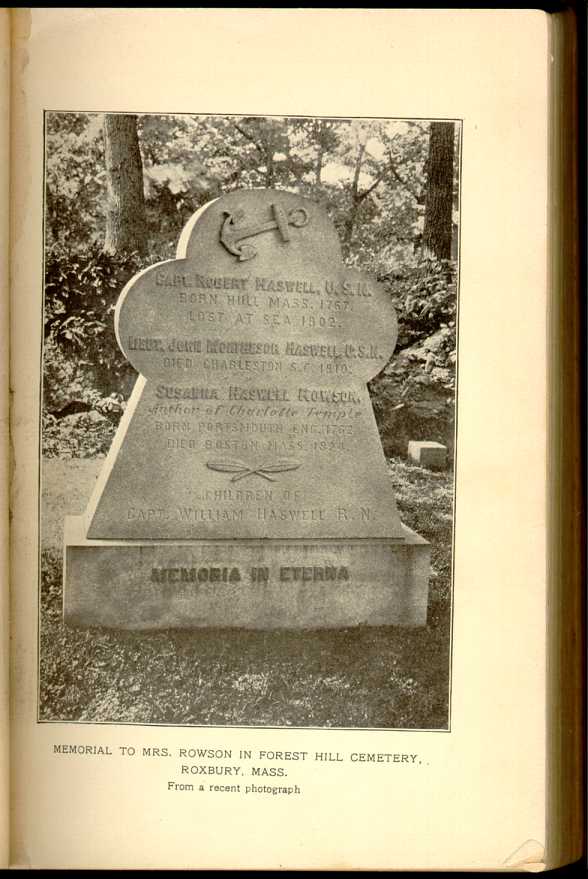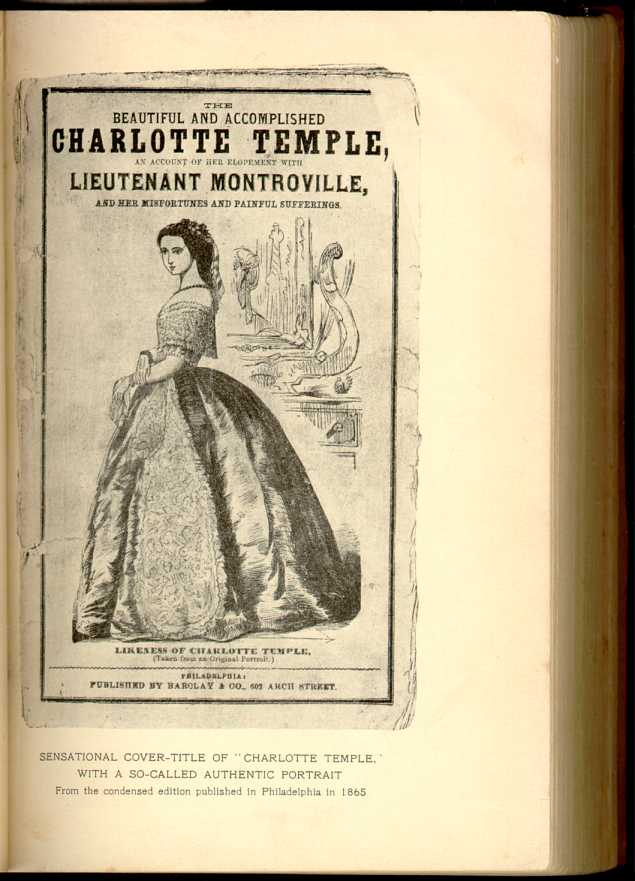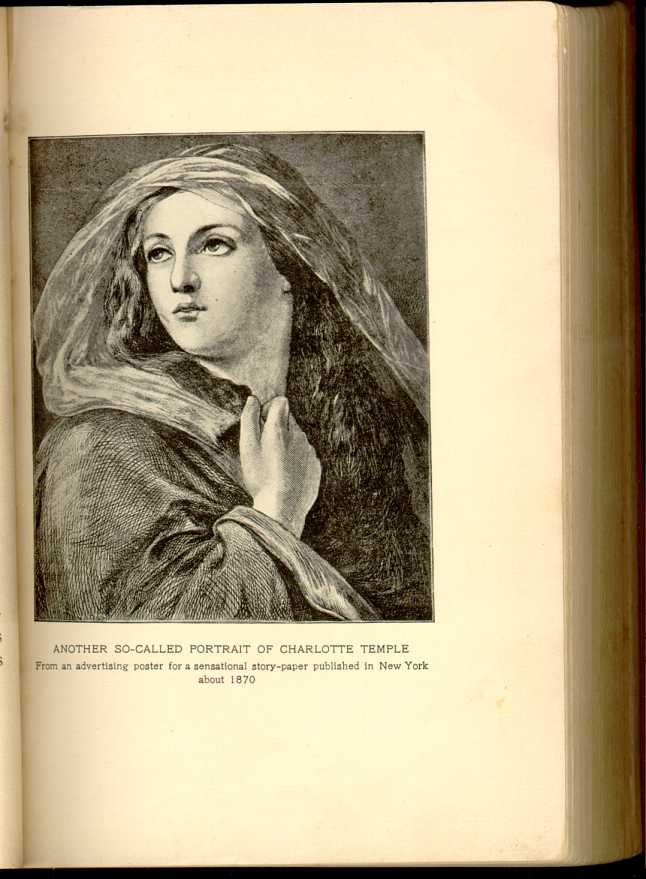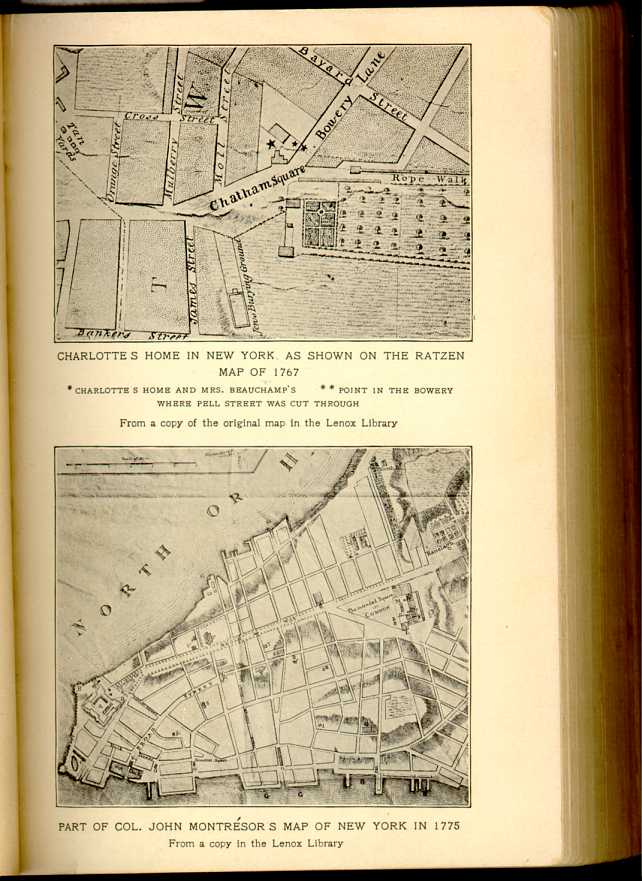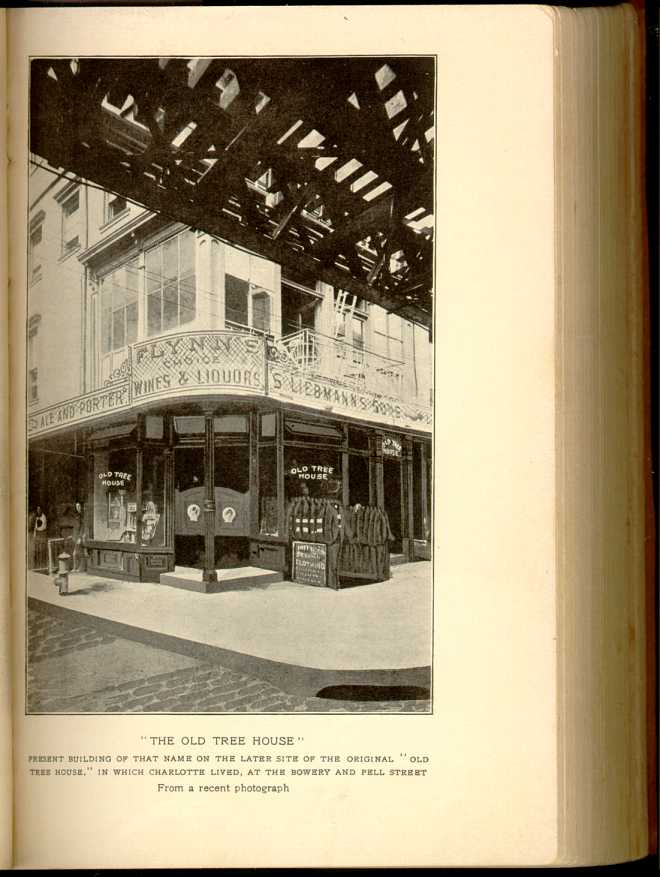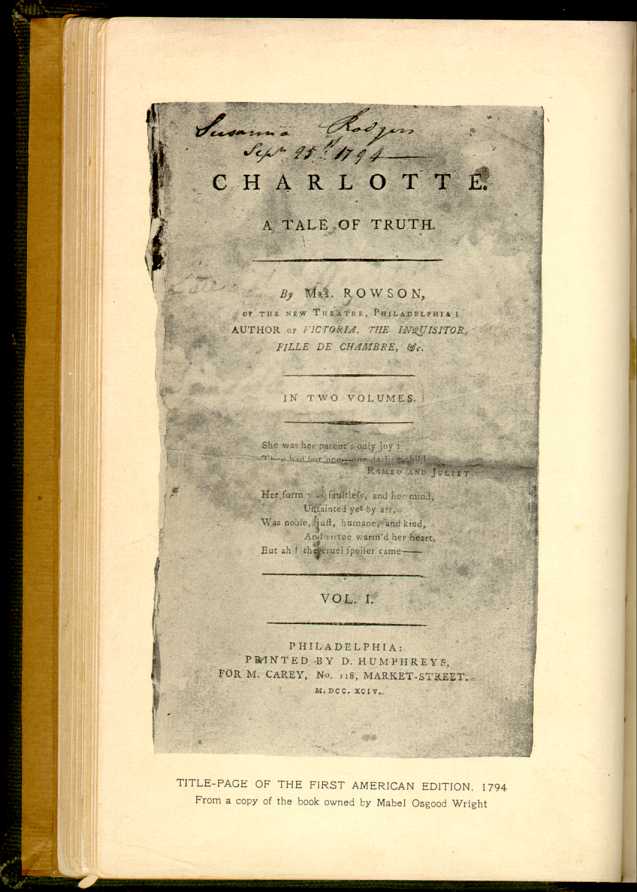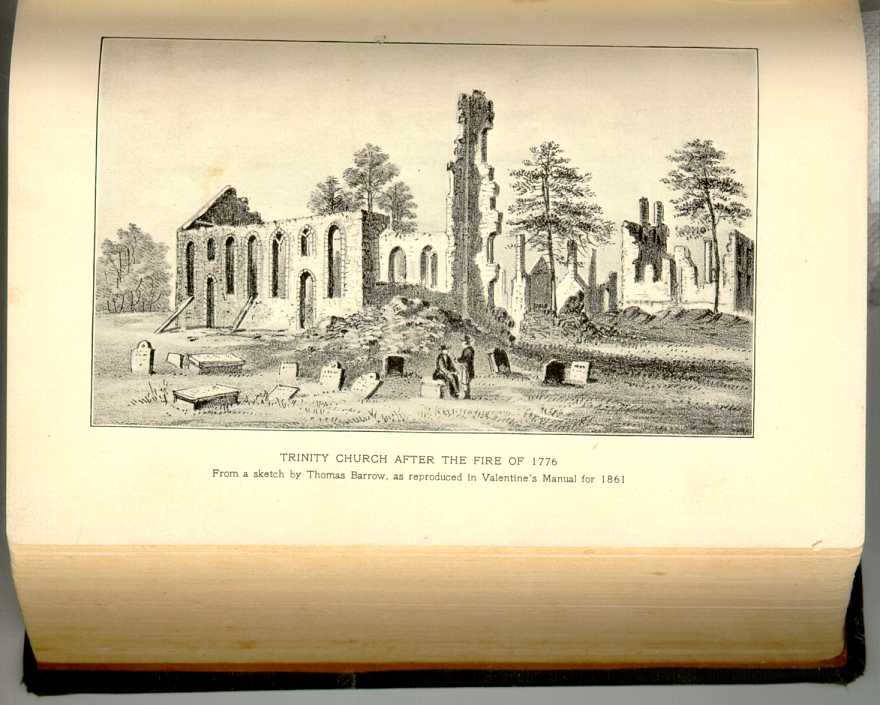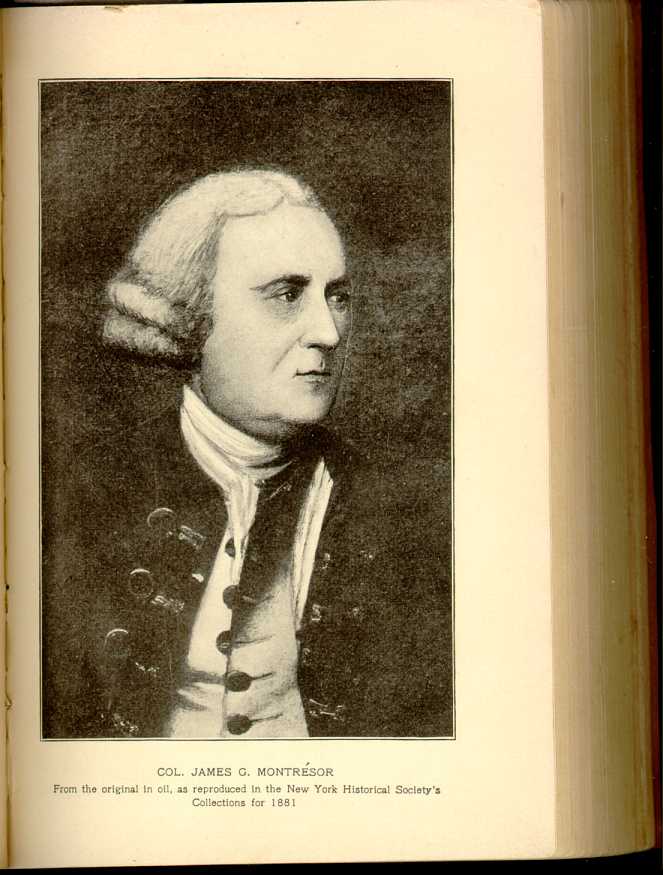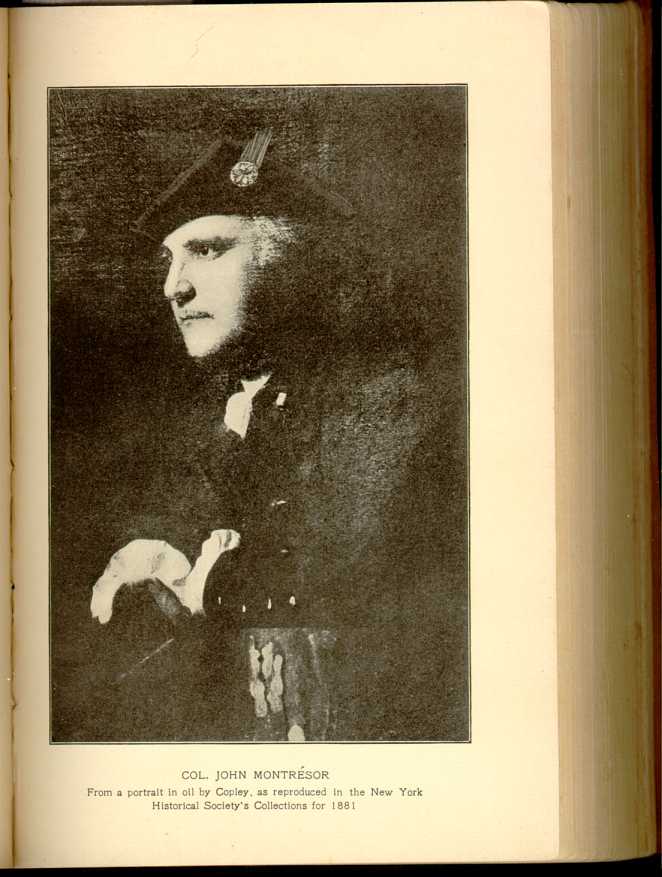1. HISTORICAL AND BIOGRAPHICAL
INTRODUCTION
INTRODUCTION
I.
MRS. ROWSON
Susanna Haswell Rowson, the author of "Charlotte Temple," was born in Portsmouth, England, in 1761. Her father was William Haswell, a lieutenant in the Royal Navy, and her mother Susanna Musgrave. In 1769 she came to America with her father, who settled at Nantasket, in Massachusetts, and remained here until 1777. She wrote, nearly twenty years afterward, in an introduction to one of her books: [1]
Her education was carefully supervised during her stay in Nantasket. She is said to have attracted the notice of James Otis, the orator and statesman, who called her "my little scholar," and endeavored to inculcate in her mind his own political sentiments, but whatever success he may have had with the daughter did not extend to the father. She adds:
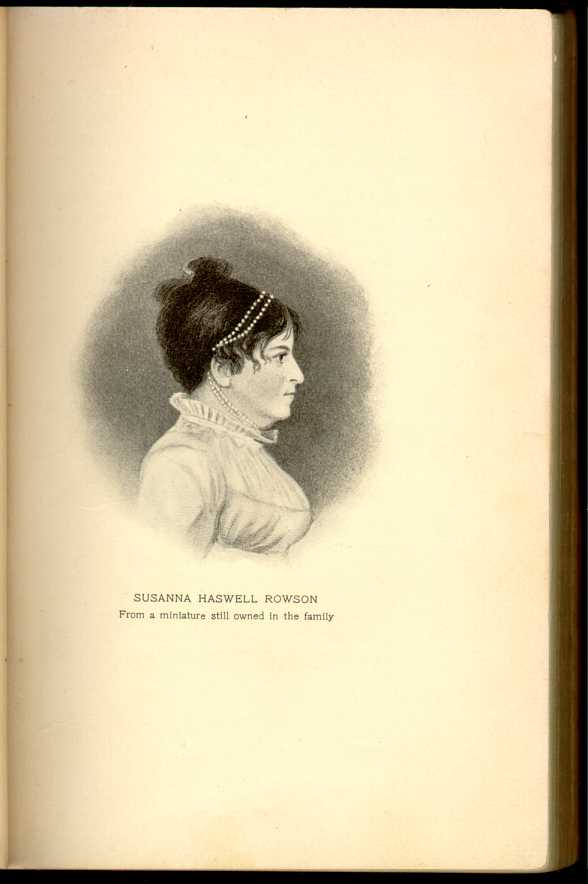 [Description: SUSANNA HASWELL ROWSON
[Description: SUSANNA HASWELL ROWSON
From a miniature still owned in the family]
A few years after her return to England she began to support herself. At one time she acted as a governess in the family of the Duchess of Devonshire. She also wrote verses, and in 1786 published a novel called "Victoria," the characters in which she described as having been "taken from real life." To assist in its Publication, subscriptions were secured, and several came from notable persons, including General John Burgoyne, Mrs.
In the same year she was married to William Rowson, a hardware merchant, serving as trumpeter in the Royal Horse Guards. Mr. Rowson soon failed in business, in consequence, it is said, of losses, through a partner in America. She and he, as well as her husband's sister, then decided to go on the stage.[2] They made, their first appearance in Edinburgh in the winter of 1792-3, and afterward acted in" several other British towns. Meanwhile
In 1793 Mr. and Mrs. Rowson entered into a contract to come to America and act in the Chestnut Street Theater in Philadelphia. When they arrived yellow fever
In 1794 appeared the first American edition of "Charlotte Temple," which was still called "Charlotte." William Cobb (the once famous "Peter Porcupine" printed a rather brutal attack upon her
Abandoning the stage in 1796, her last
Mrs. Rowson died in Boston, November 2, 1824, and was buried in the family vault of her friend, Gotlieb Graupner, in St. Michael's Church, South Boston. A granite monument to her memory was in recent years set up in a family lot in Forest Hill Cemetery, Roxbury, by her grandnieces and nephew, Mary and Haswell C. Clark, and Mrs. Samuel Osgood, born Ellen Haswell Murdock, the mother of Mabel Osgood Wright, who designed the stone. Her body was not removed
II
THE BOOK
Of the twenty-four books and plays here enumerated, "Charlotte Temple" alone has survived. But what a survival that has been! Its early success in England merely foreshadowed the success it was destined to have in America, with scarcely an interruption down to the present day — a period of one hundred and fifteen years. As a survival among books of that generation it is probably matched in this country only by Franklin's "Autobiography," if indeed that book has matched it. Among novels it had no rival in its own day-not even "Evelina" or "The Children of the Abby." None of Scott's novels, which came a generation later, could have had so wide a reading here. Not until "Uncle Tom's Cabin" appeared
Perhaps even now, in the number of copies actually printed and read, "Charlotte Temple" has not been exceeded by Mrs. Stowe's work, because, being not protected by copyright, it has been constantly issued by many publishers in the cheapest possible forms of paper as well as cloth. The editions are innumerable. I has been published in London, New York, Philadelphia, Boston, and several of the smaller American towns, including Ithaca N. Y., Windsor, Vt., and Concord, N. H. Some of the early editions were in two volumes, but all later reprints seem to have been in one, tho some have appeared in the form of two volumes bound as one. Several have had a frontispiece, some vignette, and a few have had illustration in the text, but recent editions have commonly had no illustrations save now an then a frontispiece. In size the edition have been 18mos, 16mos, 12mos, and
Duyckinck, writing in 1855, said the story was still "a popular classic at the cheap bookstalls and with traveling chapmen."[3] Reprints of it to this day are offered in department stores, on sidewalk bookstalls, and by pushcart dealers. In the little stationery stores of tenement districts it can usually be found on shelves where are kept some hundreds of secondhand or shop-worn paper covered novels. The shopkeeper will probably say he keeps "Charlotte Temple" constantly in stock, and that it is one of his best-selling books. A collector in New York many years ago had secured a large shelfful of various editions, said to number about one hundred. Mr. Nason did not exaggerate the actual facts when he offered up the following tribute to the popularity of this book:
In the best modern editions the integrity of the text has been better preserve perhaps than the circumstances, carefully considered, would have led one to expect but, as already stated, the text to-day is
Once errors had crept into the text, it can be understood how they were almost inevitably repeated at the next setting of the type. With each resetting further errors would be made, so that an edition now current might show accumulations from three, or possibly four, generations of compositors. So formidable a total of errors (1265, large and small, by actual count) gives further evidence of the extraordinary popularity of Mrs. Rowson's little book.
In one edition among those I have seen, systematic condensation of the text has occurred, and other condensed editions are known to have been published The one referred to was issued in Philadelphia in 1865, with the author's name omitted from the title-page. At least one-fourth of the matter has been eliminated, some of the chapters have be entirely rewritten, and their number reduced from thirty-five to twenty-eight. The publishers announced on the title-page that this was "the only correct a authentic edition" of the book; declared in an introduction, that it was "the on correct one ever issued," and that it has been "printed from a copy of the original publication," which of course was impossible.
It was a thin, paper-covered octave with illustrations showing styles of dress worn in 1865—that is, ninety years later than the period of the story. Besides these sensational woodcuts in the text,
it pretended to have a likeness of Charlotte, "taken from an original portrait," but looking like a fashion-plate, Charlotte being arrayed in an evening dress supported by a hoopskirt.. This stupid misrepresentation of Charlotte is reproduced elsewhere in the present volume, with the sensational cover-title which the portrait was supposed to adorn. As an appendix, an article on the tombstone in Trinity churchyard was printed with an outline of "Lucy Temple." It was written by John Barnitz Bacon.[4] Owing to these pictorial and editorial features, newly introduced, the, publishers were able to copyright this edition.
Other liberties, much more reprehensible, have been taken with the book. In the slums of large cities, many years ago, perverted editions were common, the text having been altered in a way to secure
By means of these publications, now forgotten, Charlotte's character became much perverted in the minds of ill-informed people, among whom doubtless were persons of respectability and intelligence. Something of that influence has survived to this day in the impressions
which many retain of the real character of Charlotte Temple.
The text of the rare first American edition, which appeared in Philadelphia while Mrs. Rowson was living there, has been carefully followed in this reprint. A copy was obligingly lent for the purpose by its owner, Mabel Osgood Wright. The original owner, as shown by an autograph on the title-page of the first volume, was Susanna Rodgers, the inscription being dated September 25, 1794. Except for the stains of time and twenty-one pages which in the bottom margin have been invaded by a bookworm, the copy is perfect. The two volumes are bound as one in half morocco, the number of pages for the two volumes being 87 and 83 respectively.
III
CHARLOTTE
Mrs. Rowson's stories are pervaded by old-fashioned sentiment, which it has been the custom nowadays to mention as if it were a reproach. Sentiment they unquestionably are; but whether this be a reproach, may be left an open question. Our own period is distinctly not sentimental age at least in so far concerns the expression of sentiment about which we have grown somewhat squeamish. Human nature, however, has not changed. The average man and woman remain very much what their forbears for many generations have been in their susceptibility to emotion.
The situations Mrs. Rowson describes, the sympathies she evokes, appeal to what is elemental in our nature and what also eternal. Rudimentary as to right
Mrs. Rowson was not gifted so much with creative imagination as with the power to delineate every-day human emotions. The situations which could move her were not those which she herself might have created, but those which she knew to have existed in the life she had seen. She wished always to draw some potent moral from them, holding up for emulation the staple virtues which keep the world strong and make it possible for men and women to be happy in one another's society: She was born to be a teacher, and a notable teacher she became in Boston. In her books she aimed also to teach, and in doing so adopted what we may call the "direct
"A tale of truth" Mrs. Rowson declared "Charlotte Temple" to be, and Mr. Nason describes it as "a simple record of events as they happened, and as truthful as Macaulay's sketch of Charles I." Writing of the motive of the story, Mr. Nason says Mrs. Rowson had seen so much of the scandalous lives of land and naval officers in that period that she
Mr. Nason then explains that it was
Mrs. Rowson had ascertained who the original characters were, and where the events took place. When Cobbett assailed her for expressing sentiments foreign to her heart, she said in the course of her reply:
The year of Charlotte's arrival in New York was the immediate eve of the Revolutionary War. The Boston Tea Party had taken place the year before (December 1773), and in the same month New
New York at that time was only third in population among cities in the Colonies, Philadelphia and Boston both being larger. Save for a few houses around Chatham Square, the built-up parts did not extend north of the present City Hall Park, then an unnamed piece of vacant land, described in the Montrésor map of 1775 as "the intended square or common." The only highway that led northward from the city first followed the line
The house Mr. Dawson describes is plainly shown on the "Plan of the City of New York," surveyed by Lieutenant Bernard Ratzen, of the British Army, in 1767, and published with a dedication to the governor, Sir Henry Moore. [10] A part of this map, embracing the Chatham Square neighborhood, is here reproduced. Pell Street was subsequently laid out through land on which stood Charlotte's
Mr. Dawson wrote in 1861. Since his time that remnant of Charlotte's home has been supplanted by a modern building, in which a drinking-shop is still maintained, the upper floors being used as a lodging-house of the better class for that, neighborhood. Over the doorway one still reads the sign, "The Old Tree, House." This corner of the Bowery and Pell Street is the northwest corner. Next door to Charlotte, so that "their gardens, joined," as stated in the story, lived Charlotte's friend, Mrs. Beauchamp. It will, be observed that the Ratzen map shows two buildings at that point in the Bowery.
IV
THE TOMBSTONE
The Charlotte Temple tombstone lies in the northern part of Trinity churchyard, between the eastern pathway and the iron fence that faces Broadway. It is a long brownstone slab, well sunk into the surrounding soil, and bears, without date or other inscription, the name "Charlotte Temple." The records of the parish having been destroyed in the fire which burned the church in 1776, and the inscription plate having disappeared from the stone before 1846, no means have been found for ascertaining the date of her death or burial. She is understood to have died when she was nineteen years old. Mrs. Rowson, however, gives her age at the time when she fled from England with Montraville as fifteen, and her death appears from the story to have occurred a year later-that is, in 1775, when, according
The absence of records has led to the growth of much skepticism among local historians as to the authenticity of stone as marking the grave of a woman from whose tragic history Mrs. Rowson's tale was drawn. In the family of Mrs. Rowson, however, a fixed belief has a ways existed that the stone in this sense is authentic. It has come down from Mrs. Rowson herself—among others through her niece, Rebecca Haswell Clark, who was a pupil in Mrs. Rowson's school — and through Ellen Haswell Osgood, grandniece, and nothing has ever shaken their faith in it. In Mr. Nason's biography of Mrs. Rowson, no question of its authenticity is raised. Nor does the writer of the sketch of Mrs. Rowson in "Appleton's Dictionary of National Biography" in any way qualify his statement that the Charlotte of flesh and blood was buried in Trinity churchyard.
Popular belief has not suffered appreciably from the skeptical views of local historians. After the lapse of one hundred and thirty years it still survives, active and potent. Pilgrimages continue to be made to the stone; flowers are reverently, tho often furtively, placed upon it, [11] and the newspapers periodically publish extended articles, giving details of Charlotte's life and death. [12] Neither the grave of Alexander Hamilton nor that of Robert Fulton successfully disputes its preeminence as the most popularly interesting tombstone in that famous burying-ground. In the autumn of 1903 a writer, seventy years old, who said he was born under the shadow of the spire of this church, had had the Battery for his play-
The persistent survival of this story the basis of Mrs. Rowson's romance must
Mrs. Rowson survived Charlotte's
The only item in the book in any way dealing with the subject is contained in a foot-note to an introductory sketch of the family of Montrésor, where it is stated, that Mrs. Rowson's father, William Haswell, was a brother of Mary Haswell, the mother of John Montrésor; that Mrs.' Rowson was the author of "Charlotte' Temple," and that she has assured her
Considering all the circumstances of Charlotte's life and death-that she was the daughter of an English clergyman, the granddaughter of an English earl, and that her father, on hearing of her forlorn condition, came to America from England, and was present at her death and funeral-what would have been more natural than that she should be buried in the churchyard of what was the most prominent Church of England place of worship in the city?[16]
It has often been said, and Mrs. Rowson's family still adhere to the statement,
Mr. Bacon tells essentially the same story. "A simple uninscribed headstone,"[18] he says, "marked the grave in 1800 when Lucy Blakeney visited it," and "Tommy Collister,[19] who had been for many years the sexton of Trinity, had no difficulty in pointing it out to the grave and stately lady in black who called upon him."
The two novels shed some interesting light on the name of Blakeney. In the second chapter of "Charlotte Temple" it is an army officer of that name who takes Mr. Temple to the Fleet Prison, and there introduces him to the unfortunate Mr. Eldridge and his daughter, the future mother of Charlotte. Blakeney does not again appear in "Charlotte Temple," but in "Lucy Temple" further details of his
We may perhaps assume that Mrs. Rowson, in writing "Lucy Temple," used the real name of Blakeney instead of resorting to a fictitious one. She might, properly have done so. It will be recalled
Among Mrs. Rowson's descendants it has always been believed that Charlotte's remains, some years after the burial, were removed to England. To reconcile this belief with the visit of Charlotte's daughter, we must assume that the remains were removed not earlier than 1800. The date of the removal has not been preserved in Mrs. Rowson's family, but the fact of the removal has been transmitted from Mrs. Rowson herself through her niece, Rebecca Haswell Clark.
Lucy never married. In 1800 she was twenty-five years old. Besides the Blakeney fortune, she now possessed a tidy sum which had come to her from her grandfather. Altogether, she was an pb n="lx"> heiress of some consequence. "Various and comprehensive schemes of benevolence," says the author, "formed the work of her life, and religion shed its holy and healing light over all her paths." Possibly we are warranted in entertaining a belief that Lucy came to New York in 1800, and, after having had her mother's remains taken up, caused the present stone to be erected as a permanent memorial of the place where, for a quarter of a century, Charlotte had lain in her last sleep.
The stone, as it appears to-day, has rectangular depression in its upper part about one foot by nearly two feet in size and perhaps an inch deep. At least sixty years ago the inscription plate had disappeared from this depression, and is understood to have been stolen and then recovered, but afterward to have been misplaced or lost. During the building of the present church edifice, which was consecrated in 1846, an engine-house, connected
It is clear from this statement that, among those who were engaged in building the new church sixty years ago, the stone was believed to mark the spot where Charlotte was buried, and that it originally contained a plate bearing an inscription. One naturally asks here, "Why
Mr. Bacon gives an account in detail of the theft of the plate. Two men, he says, visited the churchyard on a cloudy night, and with tools cut and forced away the lead which fastened the plate to the stone. As they lifted the plate from it bed, they were discovered by two watch-
Philip Hone, once Mayor of New York,
Would "Charlotte Temple" have lived
The history of most great successes in popular fiction proves nothing more conclusive than that extraneous circumstances, including mere advertising, never in themselves made a great popular success. If the full history were told of "Uncle Tom's Cabin," "Ben Hur," and "David Harum," the three books which, with "Charlotte Temple," have had the largest sales known to fiction in this country, it would be revealed that the advertising
"Charlotte Temple" was published in days when book advertising, if not actually unknown, was certainly unknown in the modern sense. It made its way purely on its intrinsic qualities as a book that appealed powerfully to human interest. As for the tombstone, we must not forget that the first success of the book was won in England, among readers who could never have heard that the grave of that unfortunate young English girl existed on the western border of Broadway. Its success in that country was immediate, the sale Of 25,000 copies being extraordinary for that period-the period moreover, of William Cowper, Fanny Burney, Hannah More, Mrs. Radcliff, Elizabeth Inchbald, and Anna Letitia Barbauld.
The sole assistance the work could have had, from what in a larger sense, may be called advertising, has come from
One of the most widely read novels in the English language, and probably one of the most talked about, it still remains one of those least written about. In England (for the first two years at least), it was left unnoticed by the Monthly Review, a periodical which had for its exclusive province news and reviews of books. Nor do I find any notice of it during that period in the Gentleman's Magazine, which each month devoted several pages to new publications. Poole
The only contemporary English notice which has come to light anywhere appeared in the Critical Review for April, 1791. "It may be a Tale of Truth," said the writer, "for it is not unnatural, an it is a tale of real distress. The situations are artless and effective, the description natural and pathetic. We should feel for Charlotte, if such a person ever existed, who for one error scarcely perhaps deserved so severe a punishment." In conclusion the writer remarked that, if the story be really fiction, "poetic justice is not properly distributed"—a complaint for which we may find a satisfying answer in Mrs. Rowson's fidelity to actual occurrences.
The conclusion is irresistible that the
V
MONTRAVILLE
But who was Montraville? Mrs. Rowson and her biographer, as well as others whose statements have been generally current since the story was written, have represented that he was Colonel John Montrésor, of the British Royal Engineers. Colonel Montrésor belonged to line of successful military men, and was of ancient Norman lineage. His great-grandfather, at the time of the English Restoration, commanded the troops of General Monk, which took the Seven Bishops to the Tower of London, and his grandfather was a captain of cavalry, serving in all the wars of Marlborough.
Colonel James G. Montrésor, his father, was resident for many years at Gibraltar as an engineer, and was present at the
capture in 1727. In 1747 he was made chief engineer, the defenses of the fortress being greatly improved by him between that year and 1754, when he returned to England, and was appointed chief engineer of the expedition to America under General Braddock. Having arrived with the expedition at Alexandria, Virginia, he set out in June, 1754, in command of a force which prepared the roads for Braddock's advance westward over the Allegheny Mountains, through a country largely unexplored, and leading to what is now Pittsburg. He was present at the overwhelming defeat of Braddock, where he was wounded. He made his way back with the retreating army under Washington, and was ordered to Albany, where he remained seven months, preparing plans for a new campaign in the North. He made a survey of the military positions about Lake Champlain, reconstructing a fort on Lake George, and, in 1760, erected on Fort George a new fort with
Colonel John Montrésor was born in 1736, while his father was stationed at Gibraltar. He came to America with his father, and went with him on the expedition to Fort Duquesne, being wounded in the disastrous battle. For some time he continued to serve in the Colonies as an engineer, and then went to Nova Scotia, where he was active during the long siege, of Louisbourg. In 1759 he took part in the siege of Quebec, carrying despatches to General Amherst, showing much personal bravery in doing so, and was present at the capitulation. His abilities as an artist enabled him to make an excellent likeness, in profile, of General Wolfe "in his camp at Montmorenci, near Quebec, September 1, 1759," or eleven days before the successful assault on the fortress. This portrait was afterward reproduced in mezzotint and published in London. He was employed, during the troubles
growing out of Pontiac's conspiracy, in constructing a line of redoubts at Niagara seven miles long, and in completing a fort on the shore of Lake Erie. In doing this work he made a forced march to Niagara with a regiment of Canadians.
Colonel Montrésor was married on March 1, 1764, to Frances Tucker, whose portrait, painted by Copley, still exists in England. She was the only child of Thomas Tucker, of Bermuda, and by her he had ten children, of whom eight were born in New York.[23] He purchased, in 1770, an island in the East River, which received his name and bore it for some years afterward. It is now known as Randall's Island. Here he made his home during the British ascendency, until January 1, 1777, when his house and other buildings on the island were destroyed by fire.
Mrs. Rowson departs from this marriage
During the occupation of Boston and New York by British troops Montrésor was the principal engineer in charge, and in December, 1775, received the appointment of chief engineer in America. During the twenty-four years he spent in this country he says he took part in eighteen actions, made thirty-two voyages, and served under fourteen commanders-in-chief, among them Braddock, Shirley, Loudon, Abercrombie, Amherst, Wolfe, Gage, Haldimand, Howe, and Clinton. To these names might be added that of Washington, since it was Washington who led the army back from Fort Duquesne after the defeat and death of Braddock.
Socially Montrésor was prominent in the best circles. While stationed with the Army in Philadelphia, in 1777, he became one of the managers of the Mischianza, the famous farewell entertainment
Among the engineers' maps and plans drawn up by Montrésor in America were the following: "A Drawn Elevation Part of the North Front of Albany"; "A Drawn Plan of Port Erie, 1764"; "A Drawn Plan of Fort Niagara, with a Design for Constructing the Same, 1768"; "Plan of Boston, its Environs and Harbours, with the Rebel Works Raised Against the Town in 1775"; "Plan of the Action of Bunker Hill on June 17, 1775, from an Actual Survey"; "Plan of the City of New York and its Environs to Greenwich on the North, or Hudson's River, and to Crown Point on the Sound, or East River, Surveyed in the Winter of 1775" ; "A Map of the Province of New York, with Part of Pennsylvania and New England, from an Actual Survey, 1775"; "A Drawn Survey of the City of Philadelphia and its Environs, 1777."
In 1778 Montrésor retired from service in America, and in the autumn of that year, with the British fleet of one hundred and twenty-two ships, sailed for England, whence he never returned. He speaks in his journal of his health as extremely bad. "Very ill," says he, "and a fistula coming on peu-a-peu." Again he writes: "My wounds breaking out, and the old ball lodged in me ready to start; besides, a dreadful hydrocele— -in short my existence rather doubtful should my complaints increase for want of proper assistance." The following passages from the journal as relating to his services in America are of particular interest. They were written on shipbord during the voyage home:
Colonel Montrésor remarks that "should the Colonies (after all) be lost to Great Britain, it may be attributed to a variety of unfortunate circumstances and blunders, etc.," among which he names these:
VI
THE LAST DAYS OF MONTRÉSOR AND
MONTRAVILLE
After his arrival home. Colonel Montrésor was often asked to give his views of the American war, and the causes of British defeat. Usually he did so in terms critical and even caustic, disclosing at times a bitterness of sentiment that seems to have sprung from disappointment at not securing promotion. He had ardently desired promotion in accordance with the duration and character of his services in America. Eventually he was made a colonel, but during the years in which he did his important work, including the period when he was Chief Engineer in America, his rank had been no higher than captain or major.
His failure to secure better rank could not have been due to want of a meritorious record. Nor does it seem likely that in that age of bold adventure and dissolute habits among British Army officers, the connection of his name with the tragedy of Charlotte Stanley, if known in London, would have done his professional reputation any serious harm. The more probable reason is that successful engineers the British Army at that time were not advanced in rank after the manner successful soldiers. "In the present state of the engineer corps," said he, "you can be but colonel, should you arrive to be even Chief Engineer of England."
Colonel Montrésor purchased an estate called Belmont, near Faversham, in Kent, and added to his purchase in the same neighborhood afterward. He also had a London house in Portland Place. Belmont some years later was burned, and the house of one of his sons near Belmont was also destroyed. Meanwhile he said
In 1785 and 1786 he made a tour of France, England, and Switzerland with his family, meeting in Germany several Hessian officers with whom he had served in America, including Knyphausen, then in receipt of a pension of 300 from England, with whom he dined. He complains in his journal that from the Hessians (except Knyphausen) he did not receive the most hospitable treatment, altho he had brought letters from prominent Englishmen. At the Landgravine's Court, his welcome, however, was most polite, and even friendly. He died in 1788, in his fifty-first year, his wife surviving him until 1826.
The later career of Montraville, as we obtain glimpses of it in "Lucy Temple," published more than thirty years after "Charlotte Temple," and in which he appears under the new name of Colonel Franklin (Franklin being the family name of the woman whom Montraville is represented as having Married just before Charlotte died), accords somewhat closely with known facts in the life of Montrésor. For example, the author says "his home was one of the most elegant in Portland Place," and Belmont is described as "Beliview, a large, handsome, and commodious mansion in Faversham, Kent, with several well-tenanted farms, pleaure-house, fish-ponds, green and hot, houses."
Colonel Franklin is represented as dying before his time, after a lingering illness. His character in general is summed up as that of a man possessed of "patient, noble, and generous feeling—a promise of everything that was excellent
The most striking scene in the book is that in which the author describes Franklin's death. Lucy, when approaching her twentieth birthday, had become acquainted with Colonel Franklin's son, a young lieutenant. Neither he nor she at the time knew of the relation between their parents, nor of the changes that had taken place in their own names.
Lieutenant Franklin made Lucy an offer of marriage. On her twenty-first birthday she accepted it, and her guardian the same day presented her with a miniature portrait of her mother, taken when she was sixteen years old, and bearing the initials "C. T."—a portrait she had never before seen. The arrangements
Such are the known facts in Montrésor's later biography, and such is the picture in "Lucy Temple" of the melancholy scenes amid which Colonel Franklin's life came to its untimely close. These we may
Of the substantial truth of the story told in "Lucy Temple," as affecting Colonel Montr6sor's last days, there seems to be little room for serious doubt. Samuel L. Knapp who, shortly after Mrs. Rowson's death, wrote the memoir of her that accompanies the first edition of the book (published in 1828, and the called "Charlotte's Daughter,") knew Mrs. Rowson well. After quoting the remark, made by her in reply to Cobbett's assault, that "from the most authentic sources I could now trace his [Montraville's] history from the period of his marriage to within a very few late years of his death," Mr. Knapp adds that the information which Mrs. Rowson thus declared to be within her personal knowledge, "forms the basis of 'Charlotte' Daughter.'"
VII
A CONTRIBUTION TO A BIBLIOGRAPHY
Below will be found a list of such editions of "Charlotte Temple" as have become known to me while the present edition was in preparation. Altho it contains one hundred and four editions, the list is still incomplete. It may serve, however, as a beginning for some future bibliography more worthy of the name, and with that hope it is given here. As it stands, the list probably does not contain more than three-fourths of the extant titles and imprints.
Copies of the book are not plentiful anywhere, mainly because it has been issued in small and perishable forms. In the Astor and Lenox branches of the New York Public Library may be found eleven old editions. Several of these
A search for copies of the book has been made in libraries other than the New York Public and the British Museum. After consulting some twoscore printed catalogs, English as well as American, five libraries out of the forty were found which had one edition each, and two others which had two edition. These copies, added to the eleven in the
On going to the sales catalogs of important private libraries, no better results were accomplished. At the Astor nearly two hundred catalogs, embracing the most notable sales of thirty years, were consulted, but the number of copies found in them was only eight. This of course merely shows that "Charlotte Temple" has not been a collectors' book. But who shall say it might not have been, had collectors known the excessive and increasing rarity of early editions.
Nor does one fare better when he makes a tour of the little second-hand shops. Here in the outdoor stalls may be
What is true of New York is also true of other cities. A large house in Cincinnati, in reply to an inquiry, wrote: "We have not, nor can we find in any of the second-hand shops of this city, an old edition of 'Charlotte Temple,' either in cloth or paper." No copy could be obtained from a Washington dealer, and none from Albany, while from a large
Roorbach's "Bibliotheca Americana," covering the period 1820 to 1855, names only two editions, and Sabin's list, altho the longest heretofore printed, enumerates only sixteen.[30] In the Publishers' Weekly, the trade organ of American publishers and booksellers, an advertisement has brought to light three copies. In the Saturday Review of Books, published by the New York Times, readers who had copies of the book were asked to send descriptions of them, the result being the discovery of nineteen copies in private hands.
Such, then, are the fruits of a systematic search for a book which Sabin describes as "the most popular romance of its generation." Mrs. Rowson's first biographer, Mr. Knapp, writing in 1828, said: "Three sets of stereotype plates
Considering all the circumstances, the subjoined list, incomplete tho it be in the number of editions named, and often very inadequate in the descriptions, may have interest, as I have already said, as a beginning for a bibliography.
1790 -1825
Charlotte: A Tale of Truth. By
Mrs. Rowson.London,
1790.
*The First Edition. The date 1790
is usually given, but has not been confirmed.
Charlotte: A Tale of Truth. By Mrs.
Rowson, of the New
Theatre, Philadelphia, author of "Victoria," "The
Inquisitor," "Fille de Chambre," etc. Two volumes bound as
one. 16mo, pp. viii.—9-87, 83. Philadelphia. Printed by D.
Humphreys for Mr. Carey, 1794.
*The First American Edition, of which the
present edition, as
to text, is a careful reprint. In the same year Mr. Carey issued
an American edition of "The Inquisitor."
— Two volumes in one. 16mo, pp. vi.—7-169. Second
Philadelphia edition. Philadelphia. Mathew Carey, October
9, 1794.
*The date of this edition, October 9, 1794, shows that it was
called for soon after the publication of the first, which had
probably come out in April, some advertisements by Mr.
Carey in the end pages of that edition being dated April 17,
1794.
Charlotte Temple: A Tale of Truth. By Mrs. Rowson, late of
the New Theater, etc. Two volumes in one. 12mo, calf, pp.
202 (the final pages missing). Third American edition.
Philadelphia. Mathew Carey, 1797.
*It is to be noted that in this, the third American edition, the
title had been changed from "Charlotte" to "Charlotte
Temple," and that in 1797 Mrs. Rowson had ceased to be
connected with the New Theater of Philadelphia.
The History of Charlotte Temple. Founded on Fact.
By Mrs. Rowson. Two volumes in one. 18mo, pp.
142. Hartford, Conn., 1801.
*Apparently an unauthorized edition, since the title
is changed in a way not afterward followed except in
a few isolated instances.
Charlotte Temple: A Tale of Truth. By Mrs. Rowson. Fifth American edition. Two volumes in one. 16mo, pp. 205. Harrisburg, Pa. M. Carey, 1802.
— Alexandria [Va.?], 1802.
— Two volumes in one, 12mo, pp. 168. New York, 1803.
The History of Charlotte Temple: A Tale of Truth. By Mrs. Rowson. Two volumes in one. 12mo. Catskill. Printed by N. Eliot for H. Steel. Hudson, 1808.
Charlotte Temple: A Tale of Truth. By Mrs. Rowson. Two volumes in one. 24mO, calf, pp. 137. Portrait. Philadelphia. M. Carey, 1809.
The History of Charlotte Temple: A Tale of Truth.
By Mrs. Rowson. Two volumes in one. 24mo,
pp. 143. Increase Cooke & Co., 1811.
*Has frontispiece showing a woman leaning against
a tombstone.
Charlotte Temple: A Tale of Truth. By Mrs. Rowson. 18mo, pp. 175. Windsor, Vt. Merrifield, 1812.
— Two volumes in one. Wooden boards. 24mo, pp. 180. Eighth American edition. Brattleborough, Vt. William Fessenden, 1813.
The History of Charlotte Temple: Founded on Fact.
The History of Charlotte Temple: Founded on Fact.
By Mrs. Rowson. Two volumes in one. Half roan,
16mo, pp. 168. New York. Samuel A. Burtus, 1814.
*Possibly this edition and the preceding are the same.
The inference, however, does not necessarily follow.
In one or two other instances at least "Charlotte Temple"
was issued without a publisher's name on the
title-page.
Charlotte Temple: A Tale of Truth. By Mrs. Rowson.
16mo, half roan. New York.S. A. Burtus,
1814.
*It will be observed here that Mr. Burtus issued two
editions of the book in one year-each having a different
title.
— 24mo, boards, pp.io6. Vignette portrait. New York. Evert Duyckinck, 1814. *From the above items it appears that in 1814 at least three publishers in New York were issuing the book. The type of the Duyckinck edition is very small and the paper flimsy.
— 18mo, pp. 168. Windsor, Vt. Merrifield, 1815.
— 12mo, pp. 177. Windsor, Vt. P. Merrifield, 1815.
— 24mo, boards, pp. 175. Windsor. Preston Merrifield,
1815.
*Mr. Merrifield appears to have issued three editions
in 1815, as indicated by the variations in the size and
number of the pages, and in the forms in which his
name is given. Of all the early editions, his are now the
most common.
— Two volumes in one. 16mo, pp. 132, boards. Concord, N. H. Isaac and Walter B. Hill, 1815.
Charlotte Temple: A Tale of Truth, By Mrs. Rowson. 18mo. Brookfield, Mass., 1816.
— 16mo. New Haven, 1818.
— 16mo, boards.
*Apparently a very early edition, of which a copy is
in the Astor Library, but it has no title-page.
— 12mo. Philadelphia. [n. d.]
*Apparently early.
— 24mo, pp. 138.
*An early edition. A copy is in the Society Library,
with no title-page. Has a woodcut frontispiece
showing Charlotte and Montraville returning to
the school at night.
— 12mo, pp. 152. R. D. Rider. Wallop, Hants, England, 1821.
— 18mo. Philadelphia. [n. d.]
*Apparently early.
1825 -1850
Charlotte Temple: A Tale of Truth. By Mrs. Rowson. 24mo, boards, pp. 176. New York.A. Spooner, printer, 1826.
— 18mo, boards, pp. 144. Philadelphia. John Grigg, 1826.
— 18mo, half calf, pp. 138. New York.R. Hobbs,
1827.
*Has the frontispiece showing the arrival at Portsmouth
and an engraved title, vignetted. In type, paper,
and binding the best of all the early editions here described.
— 16mo. Hartford, Conn., 1827.
Charlotte's Daughter; or, The Three Orphans. A sequel to "Charlotte Temple." Prefaced by a memoir
*The first edition. Often reprinted, and still to be had in cheap paper editions, with the memoir omitted and the title changed to "Lucy Temple."
Charlotte Temple: A Tale of Truth. By Mrs. Rowson.
18mo, PP. 138. New York. George C. Sickles,
1829.
*Has a frontispiece showing the arrival at Portsmouth,
reproduced elsewhere in this edition, and a
decorative title-page with vignette.
— 18mo, boards, pp. 138. New York. George
C. Sickles, 1830.
*A reissue of the preceding.
— 24mo, pp. 138. New York. John Lomax, 1830.
— 18mo, boards, pp. 138. New York. John Lomax, 1831. *Has a frontispiece showing Montraville and Julia Franklin entering a church to be married, the picture being repeated oil the cover.
— 18mo, pp. 138. New York. John Lomax, 1832.
— Two volumes in one. 18mo, pp. 168. Printed by Lazarus Beach for J. Harrison, S. Stephens, C. Flanagan, N. Judah, D. Smith, S. J. Langdon. New York. [n. d.]
— 24mo, half roan, boards, pp. 138. Hartford, Ct. Andrus & Judd, 1833.
— [Text in French]. Paris. [About 1835]
Die Getauschte. Ein Gemalde aus dem Wirklichen Leben nach dern Englishen (Charlotte Temple) Der Mrs. Rowson. Von Dr. J. G. Flugel. Octavo. Leipzig, 1835.
Charlotte Temple: A Tale of Truth. By Mrs. Rowson. 8vo. Leipzig, 1835.
— 24mo, pp. 148. New York. Nafis & Cornish. [n. d.]
— St. Louis, Mo. Nafis, Cornish & Co. [n. d.]
— 18mo. Cornish, L. & Co. [n. d.]
— Two volumes in one. 16mo. New York. H. M. Griffith. [n.d.]
— Two volumes in one. 12mo. New York.
Printed by John Swain for H. M. Griffith. [n. d.]
*Possibly the same edition as the preceding. A copy,
bound by William Matthews in calf gilt, was sold with
the library of Theodore Irwin, in 1897.
— 8vo. New York. John Swain. [n. d.]
— 12mo, pp. 186. New York. John Swain. [n. d.]
*From being a printer, Mr. Swain appears to have
become a publisher on his own account.
— 18mo, boards, pp. 138. Hartford. Judd, Loomis & Co., 1837.
— 18mo, pp. 140. New York. N. C. Nafis, 1840.
* Has a frontispiece showing Charlotte's grave in
Trinity Churchyard, the stone standing upright, and
inscribed " C. T.," with a willow tree drooping over
it, and a vignette on the title-page.
— Cincinnati. [n. d.]
— 24mo, London. [n. d.]
— 18mo, pp. 140, frontispiece. Philadelphia. John B. Perry, 1840 (?).
— 18mo, pp. 138. Ithaca, N. Y. Mack, Andrus & Woodruff, 1841.
— 24mo, cloth, pp. 125. Illustrated. New York.
R. Hobbs, 1842.
*Has two illustrations on steel-"The Interview of
— 8vo, pp. 60. Boston. Skinner & Blanchard, 1845.
— 24mo, paper, pp. 139, frontispiece. Cincinnati. U. P. James. [n. d.]
— 18mo, pp. 138. Ithaca, N. Y. Mack, Andrus & Co., 1846.
— 12mo. London, 1849.
1850 -1875
Charlotte Temple: A Tale of Truth. By Susanna
Rowson. 18mo, boards, pp. 140. New York.
Richard Marsh, 1851.
*Has the same frontispiece and vignette as the
Nafis edition of 1840.
— 18mo, boards, pp. 140. Philadelphia. William
A. Leary & Co., 1851.
*From the same plates as the preceding.
— 24mo, pp. 165. cloth. New York. Leavitt & Allen, 1853.
Charlotte Temple: A Tale of Truth. By Susanna
Rowson. 24mo, boards, pp. 165. Portrait. Philadelphia.
Fisher & Bros., 1853.
*Besides the frontispiece portrait, the cover has another
portrait, showing a different face and costume,
and printed in colors.
— 24mo, boards, pp. 165. Portrait. Baltimore. Fisher & Denison, 1853.
— 24mo, boards, pp. 165. Portrait. New York. Fisher, 1853.
— 24mo, boards, pp. 165. Portrait. Boston.
Fisher, 1853.
*This and the three preceding editions appear to have
been printed from the same plates, or from duplicate
sets, as the custom apparently then was with publishers,
and as it had been twenty-five years earlier.
— 18mo. New York. 1853.
Love and Romance: Charlotte and Lucy Temple. By Susannah Rowson. Two volumes in one. 12mo, pp. 129. Philadelphia. Leary and Getz, 1854
— 18mo, pp. 133. Ithaca, N. Y. Andrus, Gauntlett & Co., 1855.
18mo. New York. [n. d.]
— 24mo, pp. 165. New York. Leavitt & Allen. [About 1860.]
— 24mo, cloth, pp. 165. New York. Leavitt & Allen Bros. [n. d.]
— 18mo. New York. 1864.
Charlotte Temple: The Lamentable History of the
Beautiful and Accomplished, with an account of her
elopement with Lieutenant Montroville [sic], and
her misfortunes and painful sufferings are here
pathetically depicted. 8vo, paper, with an appendix,
pp. 59. Illustrated. Philadelphia. Barclay & Co., 1865.
*Already described on pages xxxiv and xxxv.
Charlotte Temple: A Tale of Truth. By Mrs. Rowson.
1874.
*Mentioned by Caroline H. Dall as having a large
sale, but "wretchedly printed."
Love and Romance: Charlotte and Lucy Temple. By
Susanna Rowson. 16mo, cloth. Two volumes in
one. pp. 119, 129. Philadelphia. Lippincott, 1874.
*Though printed from small type, this is the best
edition of those issued since 1855. It contains the
Preface signed S. R., but the signature and the title,
"Love and Romance," were never used by the author.
— Two volumes in one. 12mo, cloth, pp. 119, 129.
New York. Hurst. [n. d.]
Printed from the same text plates as the preceding,
but on larger paper, with a two-line border.
Charlotte and Lucy Temple. By Susannah Rowson. 24mo, vi., 5-254, frontispiece and vignette. London. [About 1875.]
1875 -1905
Charlotte Temple: A Tale of Truth. By Mrs. Susan nah Rawson [sic]. 12mo, pp. 190. New York. Lupton, 1876 (?).
— 16mo, paper, pp. 98. New York. Munro. [n. d.]
*Printed from small type, with a portrait on the
cover.
— 18mo, boards. New York. Fisher, 1880.
Charlotte and Lucy Temple. By Mrs. Rowson. 16mo. Philadelphia. Lippincott, 1881.
Charlotte Temple: A Tale of Truth. By Mrs. Rowson. Quarto. New York.Ogilvie, 1881.
— 8vo, paper. Philadelphia. Barclay, 1883.
Charlotte Temple: A Tale of Truth. By Mrs. Rowson. [German text.] 8vo, paper. Philadelphia. Barclay, 1883.
— 16mo, paper. New York. Lovell, 1884.
— Quarto, paper. New York. Munro, 1884.
— 12mo, paper. New York. Munro, 1884.
— 12mo, paper, pp. 119. New York. Munro, 1894.
— Paper. New York. Optimus, 1894.
— 12mo, pp. 119. New York. Munro. [n. d.]
— 12mo, paper, pp. 135. New York. Hurst [n.d.]
Charlotte and Lucy Temple. By Susannah Rowson. Two volumes in one. 12mo, paper, pp. 119. New York. Ogilvie. [n. d.]
— 24mo, cloth, pp. vi., 5-254, frontispiece and
vignette. London. Milner & Co. [n. d.]
*The binding of the copy examined is recent, but the
text plates and illustration seem to have been made
about thirty years ago.
Charlotte Temple: A Tale of Truth. By Mrs. Rowson. 12mo, paper, pp. 190. Chicago. Conkey. [n. d.]
— 12mo, paper, pp. 135. New York. Hurst, 1892.
— 18mo, cloth. New York. Optimus. [n. d.]
— 12mo, cloth. New York. Federal Book Co. [n. d.]
— 24mo, cloth, pp. 259, frontispiece. Philadelphia. Altemus. [n. d.]
— 24mo, half vellum, pp. 259, frontispiece. Philadelphia.
Altemus. [n.d.]
* Same plates as preceding, the text extremely corrupt.
— 12mo, paper, pp. 119. New York. Ogilvie. [n. d.]
Charlotte Temple: A Tale of Truth. By Mrs. Rowson.
18mo, paper. New York. Federal Book Co.[n. d.]
*Of the cheap paper editions here named as published
during the period 1875-1905, all but two seem now to
be out of print. The others, in well-worn condition,
may from time to time be picked tip in the little shops
of tenement districts.
— 12mo, cloth. Two volumes in one. With an
Historical and Biographical Introduction, Bibliography,
and Foot-Notes by Francis W. Halsey.
Seventeen illustrations, pp. cix., 137-150. New
York and London. Funk & Wagnalls Co., 1905.
*Reprinted from the First American Edition of 1794.
over 1200, errors corrected, and the author's Preface
restored.
From these one hundred and four editions, not to name others known to have been printed, it seems safe to conclude that few works of fiction have ever appeared in so many and such diverse forms, or in forms so perishable. "Charlotte Temple," in this sense, rises almost to a place with "The Vicar of Wakefield" or "Robinson Crusoe."
While the popularity of the book down to the present day cannot be questioned, and gives no evidence of declining, it is
Again and again have small dealers, with stalls in front areas and on side-walks, assured me that "Charlotte Temple" was one of their most active books. "Ten sales a week," said a man in Harlem. "My order is always for a hundred copies," said another in lower Sixth Avenue. "I am always selling that book," said a third on the East Side,
Obviously the readers who have been patronizing these small dealers are not responsible for those questions-and-answers which regularly and at frequent intervals for many years have appeared in the newspapers and periodicals in regard to "Charlotte Temple." These questions have rather come from the ill-informed among people really bookish, to whom, at least in the present generation, has been denied all knowledge of a book which, if it has not shared in the greatest literary fame, has at least participated in the greatest literary notoriety, of the past one hundred and fifteen years.
Footnotes
The Rowson family appears to have included at least one other actress. In the Gentleman's Magazine for October, 1790, among the obituary notices, may be read the following: "Of a billious fever, Miss Rowson, of Covent Garden Theatre, a beautiful and interesting , girl, on whose character, notwithstanding the blandishments of her situation, suspicion had never breathed."
Mr. Bacon wrote under the penname of "John Tripod," and in i87o published "A Legendary History of New York."
One of Mrs. Rowson's poems, written with the same moral purpose as " Charlotte Temple," is as follows:
The lily blossoming in the vale
Too fragile or too fair to last,
Withers beneath the untimely blast
Or rudely failing shower.
No more a sweet perfume they shed,
Their fragrance lost, their beauty fled,
They can revive no more.
If Malice seize the trump of fame
Or Envy should her poison shed
Upon the unprotected head
Of some forsaken maid;
Tho pity may her fate deplore,
Her virtue sinks to rise no more
From dark oblivion's shade."
The Mrs. Beauchamp of the story, whose husband was an officer in the English Army and served in America. Mrs. Rowson heard the story from Mr. Beauchamp after the Revolution when the army had returned and they first met in England, where the book was written, and in 1790 first published.
The Bull's Head Tavern occupied the site of the present Thalia (formerly the Old Bowery) Theater.
Introduction to "New York City During the American Revolution; being a Collection of Original Papers Belonging to the Mercantile Library Association," published in 1861.
This map, as showing streets and houses, is the most important one we have for that period. Colonel John Montrésor, in 1775, published a map, reproduced elsewhere, which is more important in a military and topographical sense, but not so satisfactory in its details of streets and houses.
In certain seasons of the year this occurs as often as once a week. The men employed in the churchyard say they never see any one in the act of placing them there. The flowers are found lying on the stone: whence they came no one knows.
The most notable of recent articles appeared in the New York Times on Sunday, July 9, 1905, when nearly a. page was given to the subject, with portraits and views, the writer being Mary A. Taft.
Besides Hamilton and Fulton, may be named Albert Gallatin, Captain James Lawrence, the Earl of Stirling and General Philip Kearney.
Collections -.of the New York Historical Society for, the year 1881. The "Montrésor Journals," edited an annotated by G. B. Scull; published by the Society.
Besides Trinity, New York at that time had two other Established churches-St. George's, in Beekman Street, a few blocks from Broadway, and St. Paul's, then, as now, at Broadway. and Vesey Street. There were two Dutch churches-the "Old," in Exchange Place, east of Broad Street, and the "New," in Nassau Street, where now stands the Mutual Life Building. Other denominations represented by a church edifice were the Jews, Lutherans, Quakers, and French Catholics.
In an article in the New York Tribune, about 187 Where she is referred to as Mrs. Blakeney, which seems to imply that she was known here under name she bears in "Lucy Temple."
In some early editions of "Charlotte Temple" a crude woodcut appears as a frontispiece, giving a view of the grave. A small upright stone is shown with a large willow-tree drooping over it, the stone being inscribed "C. T." But it seems to be a fanciful sketch.
Thomas Collister, as the Trinity Church records show, was appointed assistant sexton in 1788, and was made sexton in 1790. He appears to have served until 1816, when another sexton, Mr. Coutant, was appointed.
Letter of William H. Crommelin to the late William Kelby, librarian of the New York Historical Society, dated July 8, 1876. The original is now in the possession of the Historical Society.
"Index to Periodical Literature," 5 vols., 8vo. In this work are indexed the periodicals published in this country and England from the beginnings of modern magazine literature, late in the eighteenth century, until the present time.
The Battle of Harlem Heights, fought near the present grounds of Columbia University, and McGown's Pass, in the northeast part of Central Park, are here referred to.
With the Gordon L. Ford collection, given by Mr. Ford's sons, Worthington C. and Paul Leicester Ford.
One bookseller, to whom an inquiry by mail was addressed, made the following reply: "Please explain to me in Jewish what Charlotte Temple, and then I will see what I can do for you. I can't find out what it means." Had he been looking for a place of religious worship or for a building devoted to Free Masonry?
